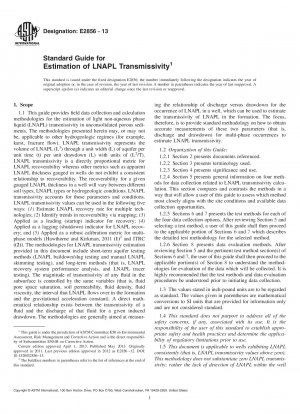ASTM E2856-13
Standard Guide for Estimation of LNAPL Transmissivity
- Standard No.
- ASTM E2856-13
- Release Date
- 2013
- Published By
- American Society for Testing and Materials (ASTM)
- Status
- Replace By
- ASTM E2856-13(2021)
- Latest
- ASTM E2856-13(2021)
- Scope
4.1.1 LNAPL transmissivity is an accurate metric for understanding LNAPL recovery, is directly proportional to LNAPL recoverability and tracking remediation progress towards residual LNAPL saturation.
4.1.2 LNAPL transmissivity can be used to estimate the rate of recovery for a given drawdown from various technologies.
4.1.3 LNAPL transmissivity is not an intrinsic aquifer property but rather a summary metric based on the aquifer properties, LNAPL physical properties, and the magnitude of LNAPL saturation over a given interval of aquifer.
4.1.4 LNAPL transmissivity will vary over time with changing conditions such as, seasonal fluctuations in water table, changing hydrogeologic conditions and with variability in LNAPL impacts (that is, interval that LNAPL flows over in the formation and LNAPL pore space saturation) within the formation.
4.1.5 Any observed temporal or spatial variability in values derived from consistent data collection and analysis methods of LNAPL transmissivity is not erroneous, rather is indicative of the actual variability in subsurface conditions related to the parameters encompassed by LNAPL transmissivity (that is, fluid pore space saturation, soil permeability, fluid density, fluid viscosity, and the interval that LNAPL flows over in the formation).
4.1.6 LNAPL transmissivity is a more accurate metric for evaluating recoverability and mobile LNAPL than gauged LNAPL thickness. Gauged LNAPL thickness does not account for soil permeability, magnitude of LNAPL saturation above residual saturation, or physical fluid properties of LNAPL (that is, density, interfacial tension, and viscosity).
4.1.7 The accurate calculation of LNAPL transmissivity requires certain aspects of the LNAPL Conceptual Site Model (LCSM) to be completely understood and defined in order to calculate LNAPL drawdown correctly. The methodologies for development of the LCSM are provided in Guide E2531. The general conceptual site model aspects applicable to this guide include:
4.1.8 Incorporation of LNAPL transmissivity can further LCSMs by providing a single comparable metric that quantifies LNAPL recoverability at individual locations across a site.
ASTM E2856-13 Referenced Document
- ASTM D5088 Standard Practice for Decontamination of Field Equipment Used at Nonradioactive Waste Sites
- ASTM D5521 Standard Guide for Development of Ground-Water Monitoring Wells in Granular Aquifers (Withdrawn 2003)
- ASTM D653 Standard Terminology Relating to Soil, Rock, and Contained Fluids
- ASTM E2531 Standard Guide for Development of Conceptual Site Models and Remediation Strategies for Light Nonaqueous-Phase Liquids Released to the Subsurface
ASTM E2856-13 history
- 2021 ASTM E2856-13(2021) Standard Guide for Estimation of LNAPL Transmissivity
- 2013 ASTM E2856-13 Standard Guide for Estimation of LNAPL Transmissivity
- 2012 ASTM E2856-12 Standard Guide for Estimation of LNAPL Transmissivity
- 2011 ASTM E2856-11e1 Standard Guide for Estimation of LNAPL Transmissivity
- 2011 ASTM E2856-11 Standard Guide for Estimation of LNAPL Transmissivity

Copyright ©2024 All Rights Reserved